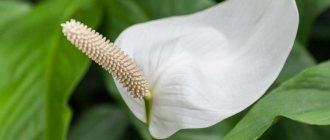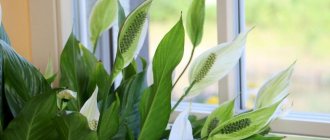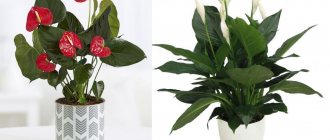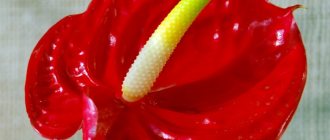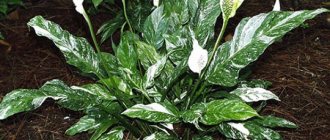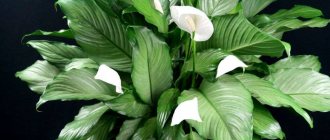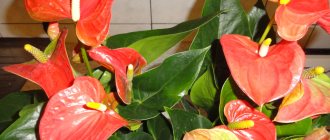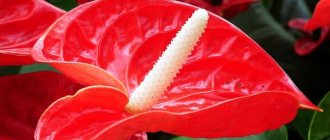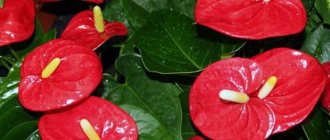It is believed that spathiphyllum or “female happiness” is a real vacuum cleaner; it perfectly cleans the air of dust and harmful fumes, and reduces the harm from radiation from office equipment. Therefore, it is recommended to start it in offices, and at home to place it in the living room or office, where there is a computer and TV. In addition, there is evidence that this plant absorbs formaldehyde from the air. (1) Considering the unpretentiousness of the flower and the ability to bloom almost continuously, the popular love for this native of South America becomes understandable.
- if a single woman plants a flower, she will soon find her feminine happiness (that’s why spathiphyllum is called that);
- spathiphyllum improves the energy of the house and is able to give the owners well-being and happiness;
- a flower is a kind of barometer of mood - if there are frequent scandals and quarrels in the house, there is no mutual understanding, then the flower begins to dry out, stops blooming and may die;
- if spathiphyllum blooms in your house, then very soon you may have a long-awaited baby - it is believed that this flower helps even those women who have already despaired of becoming a mother.
Of course, these are all nothing more than myths, but we’ll tell you only the truth about how to care for them.
Types of flower female happiness (spathiphyllum)
The genus Spathiphyllum from the Araceae family includes about 50 species. (2) Only a few of the most unpretentious ones are grown at home.
Spathiphyllum wallisii. This species was discovered in Colombia at the end of the 19th century. The species is named after Gustov Willis, a German plant collector. The plant reaches a height of 60 cm, its leaves are large, up to 25 cm (and the petiole is the same length), glossy, with spectacular wavy edges. Blooms in late autumn or winter. The flower is a yellow spadix with a white spathe, which over time acquires a pale green hue.
Within this species, about 40 varieties have been bred, which differ in size, shape of leaves and inflorescences.
- Domino (Domino) - about 50 cm high with variegated leaves: numerous white spots and specks are scattered on a dark green background, a white blanket, a flower with a faint pleasant aroma;
- Gemini . This variety is a variegated mutation of the Domina variety. Its leaves are dark green with numerous light spots;
- Picasso - with numerous large white strokes on a green background, some leaves are almost completely white, the spathe is white;
- Chopin is one of the most popular varieties, about 35 cm high, with elongated green glossy leaves, a flower with a white cover and a pleasant aroma;
- Mauna Loa - with large dark green leaves up to 20 cm long and a large white blanket.
View of Picasso. Photo: pexels.com
View of Chopin. Photo: pexels.com
Another popular species comes from Colombia. The plant is up to 50 cm high with large leaves up to 25 cm long. They have a beautiful velvety dark green color. Up to 40 leaves are formed on one plant. The cob is creamy, the spathe is first white and then turns green. It blooms profusely - with good care, a flower bud is formed in the axil of each leaf, therefore, there can be up to 40 flowers.
Spathiphyllum heliconiifolium. This species is native to the tropical forests of Brazil. The plant is very large, up to 1 m high with leaves up to 50 cm long. They are dark green, glossy, wavy at the edges. The cob is up to 10 cm long, at first white, and then darkens almost to black. The spathe is white, oval, almost twice as long as the cob.
Spathiphyllum cannifolium. Originally from Venezuela. Its leaves are similar to those of popular garden flowers - cannas. They reach a length of 80 cm, velvety, bright green. The cob is yellow-green, the spathe is white-green. The flowers are fragrant.
Spoon-shaped spathiphyllum (Spathiphyllum cochlearispathum). Native to the tropical forests of Brazil. The plant is large, about 1 m high. The leaves are up to 40 cm long, dark green, glossy, on long petioles. The cob is white, the spathe is also white, oval, shaped like a spoon - hence the name of the species.
Pleasant spathiphyllum (Spathiphyllum blandum) . This species is native to the tropical forests of Africa. Its leaves are dark green, up to 30 cm long. The cob is large, up to 20 cm long, the spathe is white-green. It grows slowly, but blooms very profusely.
This species came to us from tropical Africa. The bushes are larger than those of the Abundantly flowering one. Its leaves are elongated-lanceolate, with a retracted tip, and dark green in color. Strong long petioles. The inflorescence has a spadix surrounded by a greenish-white spathe, similar in shape to a small flag. It is this variety of Female Happiness that is popularly called Flagolist. Flowering is abundant and lasts from April to June. With good care it can bloom twice a year. It is unpretentious in everyday life, grows well in shade, although the annual growth is small.
Where can I buy?
You can purchase the plant or its seeds in specialized stores. When purchasing seeds, be sure to check the expiration date - old seeds will not sprout.
A young plant can be purchased at specialized retail outlets, greenhouses or online stores that provide not only sales, but also delivery. The price of plants varies widely, depending on the age and type of plant, location and status of the store.
Types of spathiphyllum Chopin and Cupido can be bought for 300 rubles. The average price for Spathiphyllum Mozart ranges from 1,000 rubles, and the cost of the Claudius species reaches 6,000 rubles.
Proper care of spathiphyllum will ensure its good growth. And an unusual home flower will thank the owner for her care - she will delight you with her delicate flowers with a light aroma and the bright greenery of her lush leaves. The plant will also give harmony and peace of mind, and help fulfill all your dreams and desires.
Varieties of the flower female happiness (spathiphyllum)
We have already mentioned 4 varieties that are traditionally classified as Spathiphyllum Wallis. However, there are others that are no less interesting. But it is difficult to classify them as any species - these are hybrids with the participation of many parents.
Alana . _ The hybrid is about 50 cm high. Its leaves do not droop, like many other varieties and hybrids, but stand almost vertically. Their color is rich green. The cover is white, but towards the end of flowering it turns green.
Verdi . _ A tall variety (up to 70 cm) with bright green leaves and a large pure white spathe. Whimsical, requires constant care.
Caiti . _ A very unusual cultivar, similar to the Domino variety, but on its leaves the blotches and streaks are not white, but yellow. Plant up to 60 cm high.
Sensation . _ A very large variety, with leaves up to 75 cm long and about 40 cm wide, dark green, wavy.
Sweet Silvio . A large hybrid with a large number of dark green leaves, making the bush look very lush. And its flower stalks are graceful.
Alan variety. Photo: pixabay.com
Similar plants
There is another flower that is similar in appearance to anthurium - calla lily. It has the same dark green lush leaves, bright ears and large spathes, which can be of various colors: yellow, white, pink, purple, lilac. Their main similarity is that bracts of this shape can take on the most unusual colors.
Red spathiphyllum (anthurium) is the most unusual indoor plant due to the abundance of color shades that the bract can take on. But at the same time, the plant requires no more attention than an ordinary spathiphyllum. It is only important to remember that anthurium juice is very poisonous, and therefore it must be handled with extreme care.
Caring for the flower of female happiness (spathiphyllum) at home
We talked about how to care for this flower with the chairman of the Moscow Flower Growers club, Tatyana Zhashkova.
Spathiphyllum is native to South America, which means it loves warmth. The optimal temperature for it is 18 - 25 °C. If it is lower, the plant may get sick. And this plant also does not like drafts.
Priming
In nature, spathiphyllums live in tropical forests, and the soil there is rich in organic matter. Therefore, they require fertile land to grow. The ideal composition is a mixture of turf and leaf soil, humus, peat and river sand in a ratio of 1:1:1:1:1.
Lighting
Since in nature spathiphyllum grows in the jungle, it does not tolerate direct sunlight. If bright light hits the plant directly, it can get burned, so during the sunniest hours it is better to move the plant to the shade or cover it.
Spathiphyllum tolerates shade and partial shade much more easily, but a long absence of light can affect the brightness and size of the leaves - they will be weak and small. The best option for it is an east window.
Humidity
As a native of the humid jungle, he prefers the ground to be moist, but not too wet. For spathiphyllums, special pots with built-in trays are even sold, into which water is poured and it is gradually absorbed into the lower layer of the earth. This way, harmful overflow for the flower will not occur, but moderate soil moisture will remain.
The flower also loves spraying; if you do it every day, it will reward you with bright leaves.
Fertilizers
It is best to fertilize spathiphyllums with liquid organic fertilizers with a complex of macro- and microelements.
Feeding
The “female happiness” flower needs to be fed, like all others, with complex fertilizer: once every 2 weeks in spring and summer (from April to September). And in autumn and winter it is better not to feed at all and even slightly reduce watering to give the plant a rest. If everything is done correctly, the flower will bloom all year round.
Trimming
Spathiphyllum does not require formative pruning. All you need to do is remove yellowed and dried leaves if they suddenly appear.
How does it bloom?
Blooming spathiphyllum can cause allergies.
Amazing spathiphyllum flowers in the form of an inflorescence-cob, shrouded in a delicate blanket, appear in the spring and delight the eye for 2-3 weeks. If optimal conditions and care are provided, flowers will appear twice a year. Some varieties bloom up to six months - from March to September, or all year round.
Spathiphyllum, like anthurium, can cause allergic reactions during the flowering period because it releases pollen.
Reproduction of the flower of female happiness (spathiphyllum) at home
The easiest way to propagate spathiphyllum is by dividing the bush. This is best done during plant transplantation - early in the spring.
You can even divide the bush into many parts, but it is important that each division has 2 - 3 leaves and a growth point - a bud from which young leaves grow. You need to divide the roots with a sharp knife. It is advisable that the soil remains on the roots - this way the divisions will take root better.
Each part of the plant should be planted in small pots and watered very generously at first.
It is advisable to separate young rosettes from the main bush about once every 2-3 years so that the plant does not become too thick.
Transplanting the flower of female happiness (spathiphyllum) at home
Spathiphyllum loves close quarters. It is even believed that the tighter the roots are in the pot, the more abundantly it blooms. But if you see that the roots have begun to crawl out of the pot, there are too many rosettes, and the leaves are simply crowded, then it’s time to replant.
It is best to replant the flower in the spring. If the plant is replanted as a whole, the pot should be 2 cm larger in diameter. If it is divided, then the size should be proportionate to the divisions - you should not plant them in containers that are too large, you can flood the plant.
After transplanting the flower, it is better not to water it for 5 - 6 days, wait until the soil dries completely. But you need to spray twice a day, not allowing the leaves to dry out.
Diseases of the flower female happiness (spathiphyllum)
Most often, 2 diseases occur in spathiphyllum.
Root rot. The disease can be determined by the condition of the leaves - at first they turn pale, then begin to turn yellow and wither. The cause of the disease is most often excessive soil moisture.
At the first signs of root rot, the plants should be transplanted into a new pot and fresh soil as quickly as possible, cutting out the damaged areas and disinfecting the pot.
Late blight. The first signs of the disease are rot, which appears at the base of the shoots. Then the fungus rises up the leaves, affecting the plant more and more. Diseases are provoked by too frequent and abundant watering and low air temperatures.
To treat late blight, the drugs Consento, Revus, and Ordan are used. (3)
Problems in growing
For those who grow spathiphyllum, care at home does not present any particular difficulties. However, spathiphyllum is susceptible to disease and can be affected by insect pests. Below are the most common problems that gardeners face when growing, and ways to solve them.
Leaves turn yellow and wither
This situation occurs when the soil in the pot dries out. If the spathiphyllum has dropped yellowed leaves, it needs to be watered more often to completely soak the soil. In this case, the amount of water should be increased gradually - a sharp transition from drought to abundant watering should not be allowed.
The tips of the leaves dry out
The most common causes of dry leaves are:
- planting in unsuitable soil;
- direct sunlight (causes leaf burn);
- a sharp transition from drought to abundant watering;
- watering with too cold water;
- low air humidity (especially in the heat in summer, or in winter when heating devices are on).
You can ensure sufficient humidity by:
- regular spraying;
- placing a tray with sand or expanded clay moistened with water near the flowerpot;
- special devices - humidifiers.
The leaves turn black
Black leaves of spathiphyllum can signal excess moisture, which has caused rotting of the roots.
Causes:
- frequent or copious spraying;
- low air temperature;
- lack or excess of nutrients (usually deficiency of phosphorus-nitrogen fertilizers);
- excess moisture.
With excess moisture, the leaf blades turn black, and the root system rots and dies. If the leaves turn black, the flower must be removed from the pot. After examining the root system, remove rotten roots and replant the flower in another soil.
If the leaves on the spathiphyllum have turned black due to a deficiency of nutrients, you need to feed it with complex nitrogen-containing fertilizers.
Spider mite
A dangerous pest appears on the underside of leaf blades, covering them with cobwebs. Soon the leaves begin to dry out. The diseased plant is sprayed with a soap solution, after cleaning the leaves from cobwebs with a damp sponge.
If the solution does not help, you can use insecticides and ground sulfur. Some gardeners use the following recipe in the fight against spider mites: 100 g of onion peels are poured with 5 liters of water, left for at least 5 days. The resulting solution is sprayed onto the plant.
Aphid
Black, green or gray aphids settle at the bottom of the leaf blade and multiply very quickly. The pest feeds on the sap of the plant, as a result of which the leaves begin to dry out and curl. To kill aphids, the plant is treated with a solution of nicotine sulfate (1 g of product diluted in 1 liter of water) or a soap solution. If necessary, repeat the treatment.
Shchitovka
When attacked by a scale insect, the leaf blades become covered with dark spots. The plant is treated with a soap solution with the addition of tobacco and kerosene. Then wash the flower with a clean soap solution and insecticides.
Mealybug
Mealybugs appear between the leaves due to excessive dampness. If there are not many insects, they can be easily removed with a cloth soaked in alcohol. In case of severe infection, the plant must be treated with actellik, insecticides or infusion of citrus fruit peels.
During treatment, you need to make sure that the solution does not get into the soil, otherwise not only the pests will die, but also the flower itself. After treatment, the plant is washed, and the ground is also covered with film.
Popular questions and answers
We talked with agronomist-breeder Svetlana Mikhailova about what other difficulties may await the owners of spathiphyllums .
How to choose a flower of female happiness (spathiphyllum)?
When choosing a plant, pay attention to its health - the leaves should be richly colored, without spots or signs of pests. If possible, remove the spathiphyllum from the pot and inspect the roots. If there are signs of decay or the soil smells like a swamp, it is better not to take the plant.
What kind of pot is needed for the flower of female happiness (spathiphyllum)?
Not very spacious - in large volumes, spathiphyllum soil blooms very poorly and does not last long, they like close quarters. If the plant is large, it is better to choose heavy pots, for example clay ones - they are more stable than plastic ones, and most importantly, the soil dries out faster in them, which eliminates stagnation of moisture and rotting of the roots.
Why do the leaves of the flower of female happiness (spathiphyllum) turn yellow?
Most likely, the spathiphyllum is too dry and lacks air humidity. No matter how correctly you water it, spraying is necessary. Ideally, you need a humidifier. Don’t forget that “women’s happiness” comes from the humid jungle. You can put moss in the tray to keep the roots moist. Yellowing leaves can also be a sign of root rot.
Why do the leaves of the flower of female happiness (spathiphyllum) turn black?
In the vast majority of cases, blackened leaves indicate an excess of moisture - the plant has been flooded and its roots have begun to rot. In this case, all affected leaves must be removed and the spathiphyllum transplanted into a new pot.
Why do the leaves of the flower of female happiness (spathiphyllum) dry out?
Leaves may dry out if there is a lack of moisture - perhaps the plant has not been watered for a long time. The tips of the leaves dry out when the air is too dry, as well as when there is insufficient lighting. Dry spots on the leaves are a sign of sunburn. This happens if water gets on the plants in direct sunlight.
Why doesn't spathiphyllum bloom?
Do not forget to remove the faded arrows in time as soon as the bedspread begins to turn green. The longer you keep such green inflorescences, the more vitality they draw from the plant and the fewer flowers there will be. Also, the plant may not have enough nutrition - try feeding it.
Folk signs
It got its popular name, “Women’s Happiness,” from the belief that it helps women improve their personal lives. Many mystical qualities are attributed to him:
- he helps lonely girls find a faithful and positive companion,
- a flower can scare away the groom if he has a bad character and the woman will be unhappy with him in the future,
- For married women, it helps improve relationships with their spouses. Create a comfortable family environment, full of mutual understanding and respect,
- constant scandals are considered detrimental to the plant - it begins to dry out and may die,
- a flower in the house brings prosperity and prosperity to the owners,
- They believe that spathiphyllum helps women who are desperate to become mothers. If buds appear on the plant, then the long-awaited baby may soon appear.
The decorative flower grows in Latin America, where another beautiful legend comes from. The leader of the tribe chose a bride from another tribe. The girl refused him, then the leader ordered his soldiers to destroy the village, kill all the inhabitants, and bring the girl to him. On the wedding day, the bride in a festive dress threw herself into the fire. The gods, watching what happened, turned her into an elegant spathiphyllum.
Sources
- Dorozhkina E.A. The influence of plants on the indoor microclimate and the human body // International scientific journal “Symbol of Science”, No. 4, 2015 https://cyberleninka.ru/article/n/vliyanie-rasteniy-na-mikroklimat-pomescheniy-i-organim-cheloveka/
- Plant taxonomy. Spathiphyllum // The Plant List https://www.theplantlist.org/1.1/browse/A/Araceae/Spathiphyllum/
- State catalog of pesticides and agrochemicals approved for use on the territory of the Russian Federation as of July 6, 2022 // Ministry of Agriculture of the Russian Federation https://mcx.gov.ru/ministry/departments/departament-rastenievodstva-mekhanizatsii-khimizatsii- i-zashchity-rasteniy/industry-information/info-gosudarstvennaya-usluga-po-gosudarstvennoy-registratsii-pestitsidov-i-agrokhimikatov/
